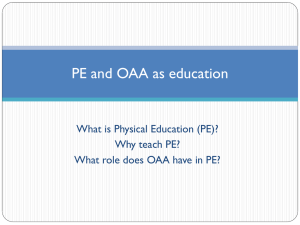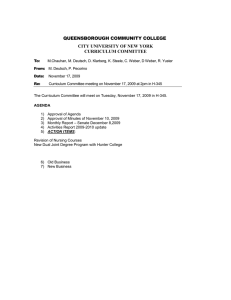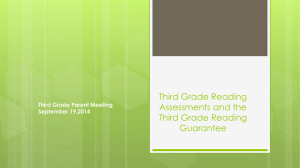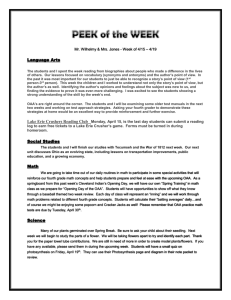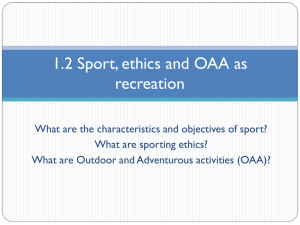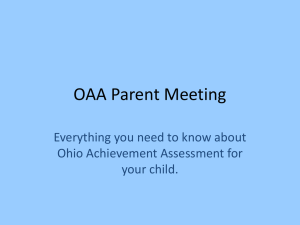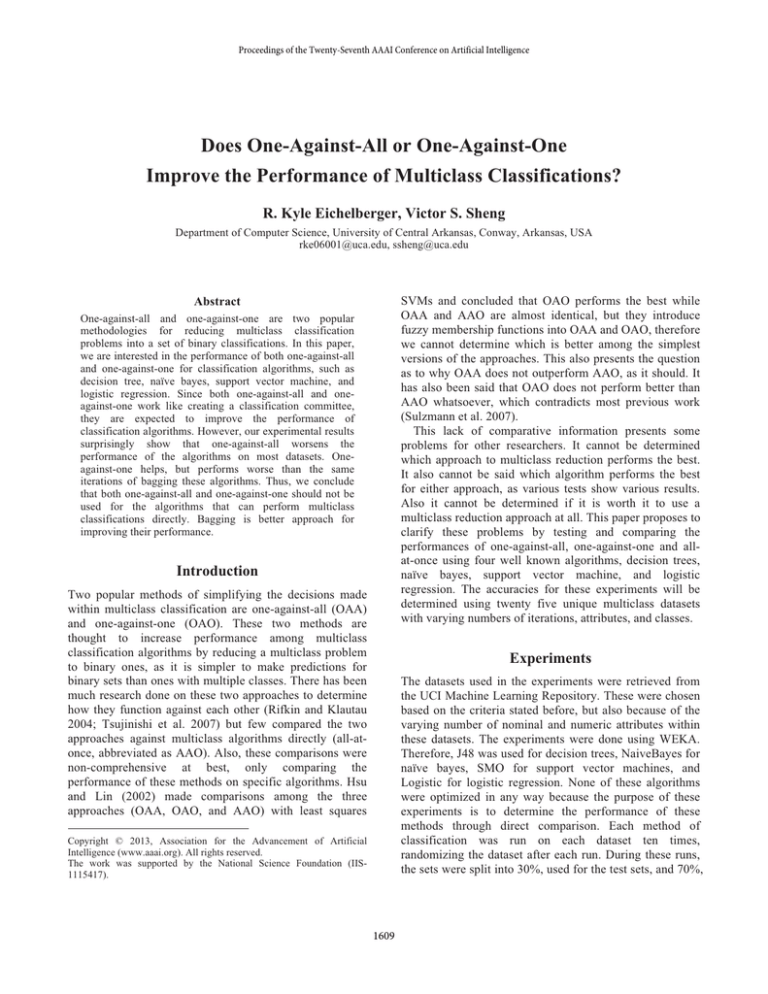
Proceedings of the Twenty-Seventh AAAI Conference on Artificial Intelligence
Does One-Against-All or One-Against-One
Improve the Performance of Multiclass Classifications?
R. Kyle Eichelberger, Victor S. Sheng
Department of Computer Science, University of Central Arkansas, Conway, Arkansas, USA
rke06001@uca.edu, ssheng@uca.edu
SVMs and concluded that OAO performs the best while
OAA and AAO are almost identical, but they introduce
fuzzy membership functions into OAA and OAO, therefore
we cannot determine which is better among the simplest
versions of the approaches. This also presents the question
as to why OAA does not outperform AAO, as it should. It
has also been said that OAO does not perform better than
AAO whatsoever, which contradicts most previous work
(Sulzmann et al. 2007).
This lack of comparative information presents some
problems for other researchers. It cannot be determined
which approach to multiclass reduction performs the best.
It also cannot be said which algorithm performs the best
for either approach, as various tests show various results.
Also it cannot be determined if it is worth it to use a
multiclass reduction approach at all. This paper proposes to
clarify these problems by testing and comparing the
performances of one-against-all, one-against-one and allat-once using four well known algorithms, decision trees,
naïve bayes, support vector machine, and logistic
regression. The accuracies for these experiments will be
determined using twenty five unique multiclass datasets
with varying numbers of iterations, attributes, and classes.
Abstract
One-against-all and one-against-one are two popular
methodologies for reducing multiclass classification
problems into a set of binary classifications. In this paper,
we are interested in the performance of both one-against-all
and one-against-one for classification algorithms, such as
decision tree, naïve bayes, support vector machine, and
logistic regression. Since both one-against-all and oneagainst-one work like creating a classification committee,
they are expected to improve the performance of
classification algorithms. However, our experimental results
surprisingly show that one-against-all worsens the
performance of the algorithms on most datasets. Oneagainst-one helps, but performs worse than the same
iterations of bagging these algorithms. Thus, we conclude
that both one-against-all and one-against-one should not be
used for the algorithms that can perform multiclass
classifications directly. Bagging is better approach for
improving their performance.
Introduction
Two popular methods of simplifying the decisions made
within multiclass classification are one-against-all (OAA)
and one-against-one (OAO). These two methods are
thought to increase performance among multiclass
classification algorithms by reducing a multiclass problem
to binary ones, as it is simpler to make predictions for
binary sets than ones with multiple classes. There has been
much research done on these two approaches to determine
how they function against each other (Rifkin and Klautau
2004; Tsujinishi et al. 2007) but few compared the two
approaches against multiclass algorithms directly (all-atonce, abbreviated as AAO). Also, these comparisons were
non-comprehensive at best, only comparing the
performance of these methods on specific algorithms. Hsu
and Lin (2002) made comparisons among the three
approaches (OAA, OAO, and AAO) with least squares
Experiments
The datasets used in the experiments were retrieved from
the UCI Machine Learning Repository. These were chosen
based on the criteria stated before, but also because of the
varying number of nominal and numeric attributes within
these datasets. The experiments were done using WEKA.
Therefore, J48 was used for decision trees, NaiveBayes for
naïve bayes, SMO for support vector machines, and
Logistic for logistic regression. None of these algorithms
were optimized in any way because the purpose of these
experiments is to determine the performance of these
methods through direct comparison. Each method of
classification was run on each dataset ten times,
randomizing the dataset after each run. During these runs,
the sets were split into 30%, used for the test sets, and 70%,
Copyright © 2013, Association for the Advancement of Artificial
Intelligence (www.aaai.org). All rights reserved.
The work was supported by the National Science Foundation (IIS1115417).
1609
used for the training set.
It was determined that OAA and OAO held an unfair
advantage over AAO. This advantage comes from the
number of models used to make predictions for each
approach. OAA uses n number of models to make its
predictions, where n is the number of classes. This results
in n binary problems being solved by the algorithm in use,
while only one model is used by AAO. The same can be
n(n 1)
models to make its
said for OAO, only it uses
2
predictions. This number is derived from the number of
combinations necessary to make comparisons for every
class value in the dataset. In order to level this advantage,
comparisons were made with two additional approaches.
These approaches will be called AAOvsOAA (for
comparison with OAA) and AAOvsOAO (for comparison
with OAO). These approaches use bagging to build
multiple models. AAOvsOAA uses bagging to build n
number of models while AAOvsOAO uses bagging to
n(n 1)
number of models. Comparisons are only
build
2
done between these approaches and their respective
counterparts.
The accuracies, including the standard deviation, were
determined for each dataset. Those accuracies and standard
deviations were averaged across the four algorithms and
are shown in Table 1. Table 2 shows the comparisons
amongst the three methodologies (OAA, OAO, AAO) and
its variants (AAOvsOAA and AAOvsOAO) via the twotailed t-test using a confidence level of 90%. We can see
that the comparison result of OAA against AAO using J48
as the base learner is (3/16/6). That is, OAA only wins on
three datasets, but loses on six datasets, and ties on the
other datasets. Using this format for wins/ties/losses
several things can be determined. First, OAA is
outperformed in every comparison, losing 39 times to
OAO, 30 times to AAO and 39 times to AAOvsOAA with
only 16 wins total.
OAO performs much better that AAO, winning 22
times over AAO, but fails to outperform AAOvsOAO,
only winning 6 times and losing a total of 15. These results
are reflected in Table 1, with the average accuracies for
OAA being the lowest method on all of the algorithms
except for naïve bayes, on which it only outperforms AAO
slightly. OAO performs the best on average for J48 and
Logistic, but when compared to the averages for
AAOvsOAO, it falls short on every algorithm but Logistic.
Thus it can be determined that OAA is not a good
approach for improving the performance of multiclass
classification algorithms while OAO performs much better
than OAA across the board and can improve the
performance of standard multiclass classification
algorithms. The performance of OAO is, however, due to
the high number of models it builds. If bagging is used to
build the same number of classes as OAO, it is shown that
the bagging technique performs better. This can be applied
to both OAO and AAO.
Table 1. Average accuracies (%) of all the approaches with the
four algorithms over the 25 datasets.
OAA OAO
77.32 ± 79.65 ±
J48
1.81 2.79
73.49 ± 73.40 ±
NaiveBayes 3.04 2.81
66.67 ± 77.10 ±
SMO
2.71 2.69
76.55 ± 78.90 ±
Logistic
2.60 2.43
AAO
78.02 ±
2.68
73.12 ±
2.57
77.98 ±
2.31
77.75 ±
2.60
AAOvs
OAA
80.69 ±
1.77
73.63 ±
2.26
77.73 ±
1.77
78.42 ±
1.71
AAOvs
OAO
81.31 ±
1.47
73.66 ±
2.31
77.88 ±
2.06
78.79 ±
2.34
Table 2. Summary comparisons (#wins/#ties/#loses) among the
methodologies with the four algorithms over the 25 datasets.
OAO AAO
OAA 1/12/12 3/16/6
J48
OAO
10/15/0
OAA 1/20/4 2/20/3
NaiveBayes
OAO
1/24/0
OAA 1/11/13 0/11/14
SMO
OAO
2/22/1
OAA 1/14/10 3/15/7
Logistic
OAO
9/16/0
OAA 4/57/39 8/62/30
Summation
OAO
22/77/1
AAOvs AAOvs
OAA OAO
1/11/13
1/16/8
1/20/04
1/24/0
0/12/13
0/21/4
2/14/9
4/18/3
4/57/39
6/79/15
Future work will be done in order to evaluate the performance of variants of OAA and OAO, such as weighted
OAA and OAO. OAA creates imbalanced training datasets
since it merges the examples of the rest classes into one. Is
it a potential reason why OAA performs worse than AAO?
Another interesting topic is to investigate the potential
problems for OAA and OAO if the original datasets are
imbalanced. Besides, we will further study the possibility
of extending the existing approaches of reducing multiclass
classifications into multi-label classifications.
References
Hsu, C.W., Lin, C.W. 2002. A Comparison of Methods for Multiclass Support Vector Machines. IEEE Tran. On Neural Networks 13(2):415-425.
Rifkin, R., Klautau, A. 2004. In Defense of One-vs-All Classification. Journal of Machine Learning Research 5:101-141.
Sulzmann, J., F¨urnkranz, J., and H¨ullermeier, E. 2007. On Pairwise Naive Bayes Classifiers. In Proceedings of the18th European
Conference on Machine Learning, 371-381. Warsaw, Poland.
Tsujinishi, D., Koshiba, T., and Abe, S. 2007. Why Pairwise is
Better Than One-Against-All or All-at-Once. IEEE International
Joint Conference, 693-698.
1610

